The calm after the storm
Synopsis : What can you do with the spare nucs and queens left after successful swarm control? After a ‘month of mayhem’, calm descends on the apiary and there are queens to mark, colonies to unite and – thankfully – a bit more time for everything.
Introduction
The first half of the beekeeping season – yes, for me at least, more than half of it has gone already – started very slowly. The long, cold early Spring seemed to delay colonies from making swarm preparations, though they certainly built up strongly by foraging hard when conditions were suitable and there was a lot of pollen in the boxes.
And, because colonies were strong and running out of space, when things finally warmed up everything went a bit mad.
Fortunately, my apiary visit at the beginning of this week suggests that the ‘month of mayhem’ is over and it should now all be plain sailing until the end of the season.
No longer do I feel as though I’m playing ‘catch up’ all the time, juggling a dozen metaphorical plates to get a good honey crop and not lose swarms, desperately searching for spare equipment, or cursing my lack of frames, or dummy boards or – most recently – those little plastic ‘candy’ caps for JzBz queen introduction cages {{1}}.
And, appropriately, these apiary visits were periodically interrupted by some spectacular cloudbursts … but, as I drove home in the calm afterwards it was clear both I and the bees had weathered the storm and things were looking good for the summer honey and the remainder of the season.
’Spare’ nucs and swarm control
My favoured swarm control method involves preparing a nucleus colony with the old queen and letting the original hive requeen itself.
If things go wrong then I’ve always got the old queen safely tucked away and she can be pressed back into service without too much interruption to the colony. The ‘old’ queen generally isn’t all that old and she will normally perform OK for many more months, though they are sometimes superseded late in the season and you’ll find an unmarked queen in the box the following Spring.
But if things go right you’re left with a ‘spare’ nuc.
Before deciding what to do with the nuc have a quick check on the queen it contains.
It’s sometimes not the one you put there.
I see this a couple of times each season. The nuc probably attempts to swarm with a clipped queen, the queen is lost, the swarm returns and the nuc requeens. Alternatively, the nucleus colony might simply supersede the original (ageing) queen.
I’m not sure I could reliably determine which of these happens without, a) seeing the nuc swarm, b) observing the accompanying brood break, or c) finding a laying queen and a mature queen cell (or two queens) during an inspection.
And this is further confounded by the comment made from Eoghan Mac Giolla Coda on ’imperfect supersedure’ in response to the post a fortnight ago. This involves the loss of the older queen before emergence of the new one, and consequently does create a brood break.
But whatever the mechanism, the outcome is a nuc headed by a current year’s queen 🙂 .
What are the options?
There’s almost a limitless range of things you could do with a spare nuc, but the majority of mine usually end up being:
- United back to the original colony – or another colony – to boost the workforce for the summer nectar flow. The old queen needs to be removed before uniting or you risk losing the (presumably younger) queen heading the production colony. I’ll return to uniting later in this post.
- Requeened by adding a cell reared from a grafted larva.
- Used as a comb and brood ‘factory’. Nucs rapidly outgrow their space unless frames are regularly removed. These brood-containing frames are used to supplement other colonies (after shaking off the adhering bees), merged with the adhering bees to produce cell raisers or – supplemented with a mature queen cell or virgin queen from the incubator – used to produce additional nucs. As long as the nuc is not weakened too much you can keep removing full frames and providing new frames which they will draw and fill. The nuc will need feeding if there is a dearth of nectar. This is a very useful strategy but requires good observation and the ability to judge how the colony is developing week by week.
- Retained for overwintering to make up for any winter losses or for sale the following Spring. For the former it really helps to have a requeened nuc and for the latter it is essential. Young queens lay late into the autumn, producing an abundance of winter bees and these little colonies overwinter well.
- Sold on or donated to a beginner. In both cases the nuc should have a current year’s queen.
- Built up into a full colony for honey production (again usually after requeening).
I often do 3+2+4 … in that order.
Supersedure again (briefly)
A couple of weeks ago I discussed adding a foil-wrapped (or perhaps more correctly foil-protected as the entire cell is not wrapped, but the tip – through which the queen will emerge – is left exposed) queen cell to a queenright colony with the intention of inducing supersedure (‘enforced’ supersedure?).
I did this with a small number of colonies – both full hives and nucs – all of which were successfully requeened and now contain a new unmarked and unclipped laying queen 🙂 .
I couldn’t find the original queen in these colonies but didn’t search them exhaustively. It was 15 days since the cells had been added … ample time for the new queen to emerge, mature, mate (we’ve had excellent queen mating conditions) and start laying.
Without knowing when the original queen disappeared it’s difficult to know whether there was an interruption to egg laying and, as I stated in the post on supersedure, I don’t know the fate of the original queen.
Did the colony stop supporting her as probably happens in ‘normal’ supersedure or did the new queen simply slaughter her?
Something to try and determine next season …
Marking queens
With requeened hives following swarm control, and superseded queens in some of the nucs, I spent part of the afternoon marking and clipping queens. This is one of those activities that, by the time I’ve done 8 or 10, just goes like clockwork.
No drama, no crisis.
Everything just works – find her, drop her into the marking cage, put the frame down safely, walk over to my ‘marking station’ in the shade, clip her, mark her, leave her while the paint dries (go through the rest of the box), shake her gently to the bottom of the cage and lay it onto the top bars of the frame … and she’ll walk down into a seam of bees with no fuss.
However, despite probably marking hundreds over the years, the ‘valuable’ queens such as those in nucs destined for sale {{2}}, or the very first of the afternoon, often involve a few jitters.
Finding the queen is usually pretty straightforward unless the colony is boiling over with workers. In nucs it’s a doddle.
If the queen has only recently started laying she’ll almost certainly be on one of the central frames with eggs. Unless of course you’ve ’kippered’ the colony by using too much smoke, in which case she could be almost anywhere.
Picking up the queen is also usually relatively easy. However, this is very much not something that ”If at first you don’t succeed, try, try again”.
Every successive failed attempt you make results in the queen getting more agitated. She starts to run about. She’ll flap her wings frantically and try to burrow into the corners of the frame.
If that happens leave it until next week.
Many hands make light work … but I’ve only got two
I originally used “crown of thorne’s” marking cages but feared impaling the queen or nearby workers on the spikes, so now use “turn and mark” cages with a foam-topped plunger.
Holding the frame with the queen, picking her up, putting the frame down and placing the queen into the cage is easier with more than two hands.
Make sure you have an idea where you are going to place the frame. You’ll only have one hand to do this as the queen is in your other hand. I usually balance the frame on one lug and the bottom bar in the open hive, or between the rails of the hive stand.
You can do this safely – by which I mean without crushing bees, dropping the frame or jarring the hive – when holding the frame by just one lug. You cannot easily lower the frame into the brood box using one hand.
It’s not unusual for a flying worker or two to investigate the queen you’re holding. Sometimes they even behave aggressively towards her (despite presumably being from the same hive).
I move away from the hive to mark and clip the queen. This avoids being buzzed by inquisitive workers which isn’t ideal if you’re trying to clip her wing without amputating a leg. I usually leave the Posca pen and scissors in a shady corner of the apiary.
Not deep shade, I need to be able to see what I’m doing, but out of direct sunlight so I can safely leave the caged queen there for a few minutes while I sort out the hive.
When returning the queen let her walk out of the marking cage quietly.
A limping queen
In one hive I found a laying queen and eggs laid in what looked like day-old queen cells. The queen had only laid a frame or so of eggs, but there were no young larvae so it was clear she had not been laying for more than 3 days. This queen had taken a long time to get mated and the colony was totally broodless.
The eggs were positioned correctly at the bottom of the cells but there were a lot of missed cells and her overall laying rate was probably less than I would have expected.
And a closer look at the queen showed why … her left rear leg was paralysed and being dragged along behind her.
This is a poor video (again too few hands!) and the frame had been out of the hive for a long time so the queen was a bit agitated. In an earlier attempt to video her she’d resolutely failed to move but she had the expected retinue of workers around her.
It looked to me as though the colony ‘knew’ there was something wrong with the queen and the early queen cells were an indication they were going to supersede her.
Rather than wait another 3+ weeks for a replacement I decided to remove the limping queen and simply unite the colony with one of those ‘spare’ queenright nucs I had in the apiary.
Uniting colonies
The day was one of sunny intervals interspersed with very heavy showers and there was a gusty wind blowing.
I usually unite colonies by laying a couple of overlapping sheets of newspaper over the brood box and then, after making a small central(ish) hole with the tip of my hive tool, gently place the second brood box on top.
Some suggest it’s OK to do this with an ageing queen in one box and a young queen in the other, trusting that youth will prevail in the eventual confrontation.
I don’t.
Why leave it to chance?
I remove the queen I don’t want, stack the boxes separated by newspaper and close the hive up. This is almost always successful.
On a windy day it can be tricky keeping the sheets of newspaper in place long enough to add the second brood box. Again it’s one of those situations when you need more hands.
The obvious answer is to use pins to hold the newspaper in place. The type shown above (I think they’re termed ‘push pins’ when sold) are easy to handle with gloved hands and are much more useful than standard drawing pins in my opinion. You can buy a magnetic tool to push drawing pins in place but it’s one more thing to lose in the depths of the bee bag.
Uniting nucs
If I’m uniting a nuc with a full brood box I usually transfer the nuc frames into a second brood box and use a ‘fat dummy’ to occupy the vacant space.
This works well and saves having to either fill the upper box with spare frames or invest (or more likely bodge together) a dedicated uniting board that accommodates the different floor areas of the two boxes but that sits unused in the shed for 51 weeks of the year.
Avoiding brood frames packed with nectar
But the summer nectar flow is ramping up.
Blackberry is flowering and the rosebay willow herb has already started. If I’m lucky (I won’t be, it’s been too dry) the lime will start in 7-10 days.
All of which means that I would end up with a double brood box, somewhat underpopulated with bees, during a strong nectar flow. Irrespective of the supers further up the stack, this usually means that some of the brood frames in the upper brood box will be used for nectar storage.
Yes, as the colony expands they might move it up into the supers … but they might not. And if they don’t I either have to extract from brood frames or, once capped, store them for overwintering nucs.
I’d prefer the nectar/honey went directly into the supers 🙂 .
So, back to that limping queen … I removed her 🙁 . There was no brood in the colony (other than a frame or two of eggs) but the nuc was packed with bees and brood.
I simply removed 5 empty frames from the queenless brood box, shaking any bees back into a central gap. I gave the top of the brood box and the underside of the nuc a quick spray with a cheap and cheerful {{3}} air freshener and placed the nuc frames into the middle of the brood box. While transferring the frames I ensured that the queen was present.
The air ‘freshener’ {{4}} masks the different hive scents and, by the time it dissipates, the colonies have mingled.
In terms of protecting the added queen you could possibly do this without the air freshener, but I’d also prefer the bees on the periphery didn’t fight.
Introduced virgin queens
Last week I briefly discussed how I had let some queens emerge in an incubator and then introduced them to a colony a few days later.
The queens emerged on a Friday into their Nicot cages and were added to nucs in fondant-plugged JzBz queen introduction cages the following Monday.
One week later I located the queens in their nucs.
All were ‘plump and swaggering’, giving every impression that they were now mated, though a perfunctory search suggested that none were yet laying. There’s usually a delay of 48-72 hours between mating and the onset of egg laying.
The difference in appearance between a skinny, skittish virgin and a mated queen – even those yet to start laying – is very striking.
I have every expectation these nucs will have laying queens in them when I next prise off the lids.
Queen mating in Scotland can get a bit hit and miss later in the season. I will be rearing more queens but would be surprised if we have such good weather in the next 4-6 weeks for mating. It’s therefore likely that at least some of these nucs will end up being overwintered. I’ll need to ensure that they don’t get too strong, so – as outlined above – will periodically remove frames of brood (used to boost honey production colonies) to keep them in check.
Taking stock
~10-20% of my colonies have needed no swarm control. These were all used to provide bees and brood for preparing a queenless cell raiser. They were very strong colonies but a combination of acute observation and skilful beekeeping simple dumb luck meant they all appear to have stayed in the box … and generated a considerable surplus of honey.
I ‘lost’ one swarm but recovered it from under the shed a few days later. I did lose a few clipped queens when colonies attempted to swarm and were thwarted, but I’m not aware I lost the workers from any of my hives (though there’s still time for a second round of swarming in mid/late July if the weather is good).
However, with the remainder of hives either containing mated and laying queens, mated queens or – in the case of the nucs made up with cells from the Hopkins method of queen rearing – recently emerged queens, everything now feels more or less under control.
I’ve piled supers onto all of the strong hives and will now focus on preparing some of my west coast colonies for the heather. The bell is already flowering and the ling will be along in ~5 weeks, or perhaps less as everything feels a bit ahead of itself this year. A reasonable heather crop is something I’ve singularly failed with previously, so there’s lots to learn (i.e. lots to get wrong).
But on these endless summer evenings it’s also good to take some time away from the bees and paddle across the loch to join the dolphins chasing the mackerel on the incoming tide or – less appealing – see some of the largest Lion’s mane jellyfish I have ever encountered 🙁 .
{{1}}: Found them … bee-equipment.co.uk (defunct) … £1.27 for 10 or £13.84 for 100!
{{2}}: Damage the queen, lose the sale.
{{3}}: Other adjectives that apply include ‘smelly, ‘repellent’ and ’noxious’.
{{4}}: And I use that term in the loosest possible sense.

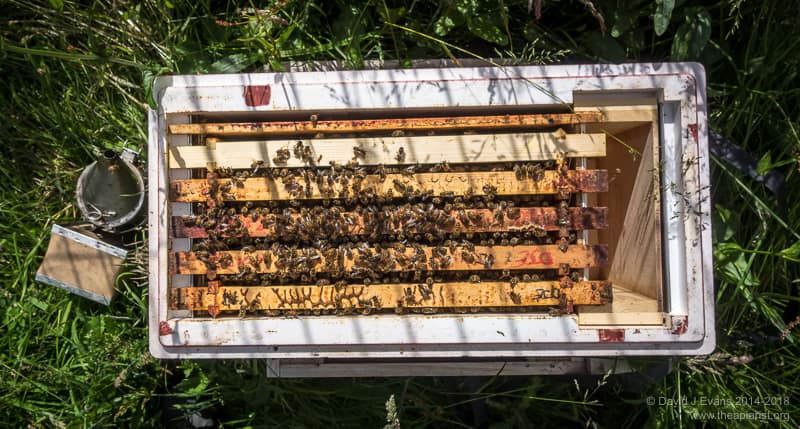
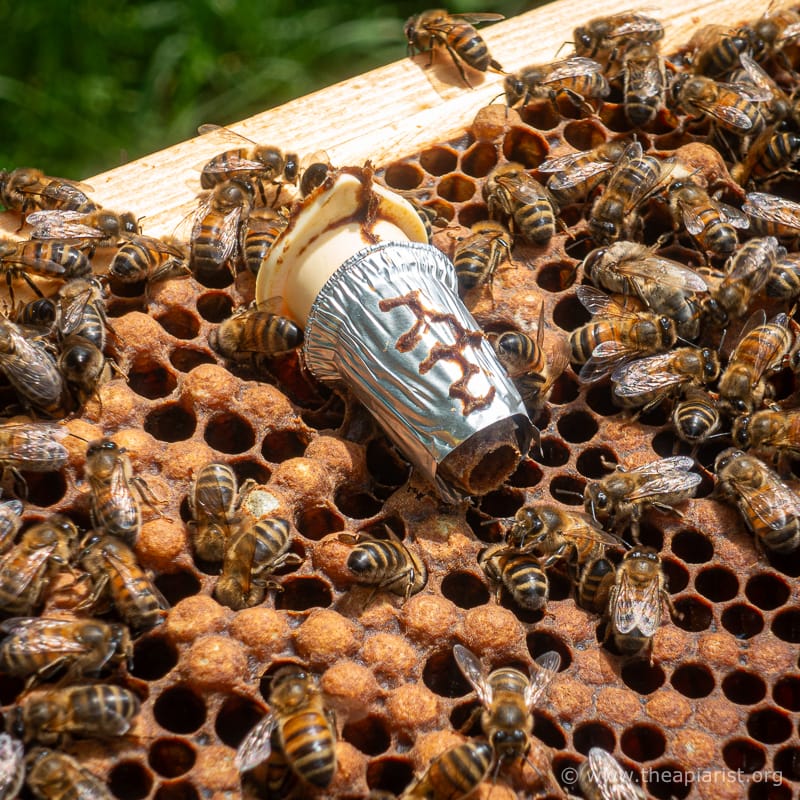
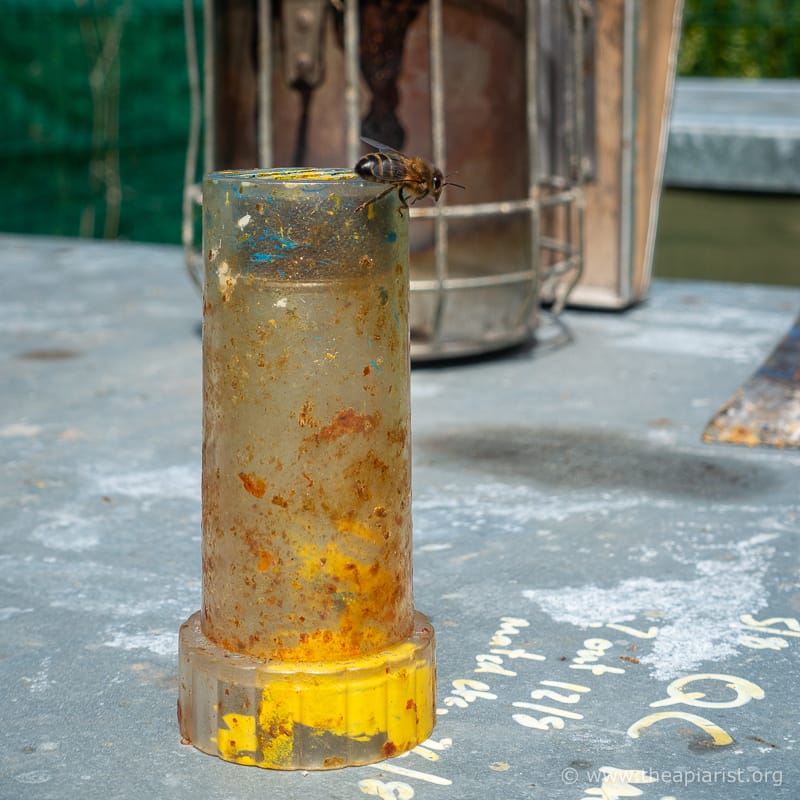
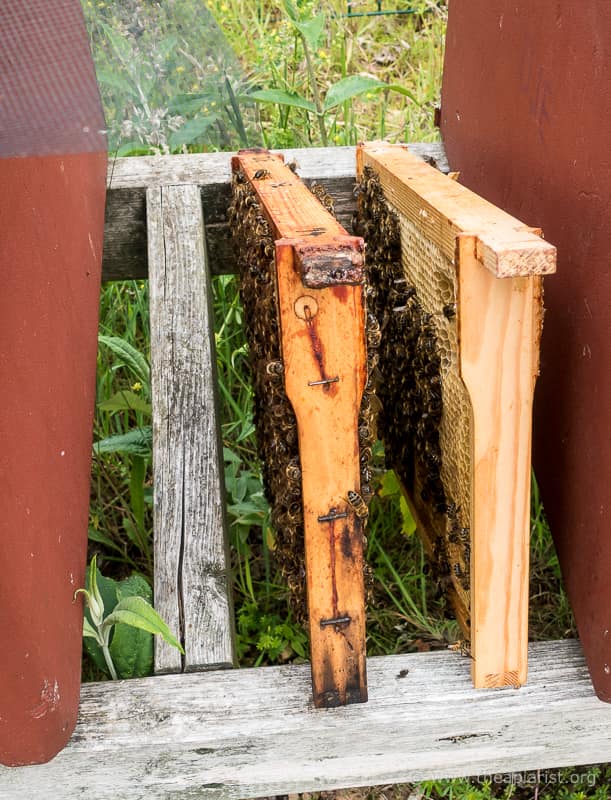
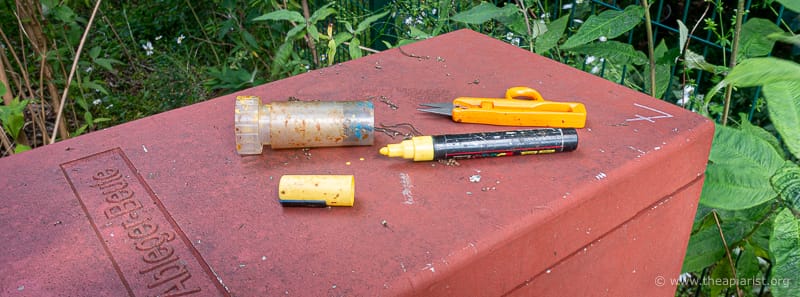
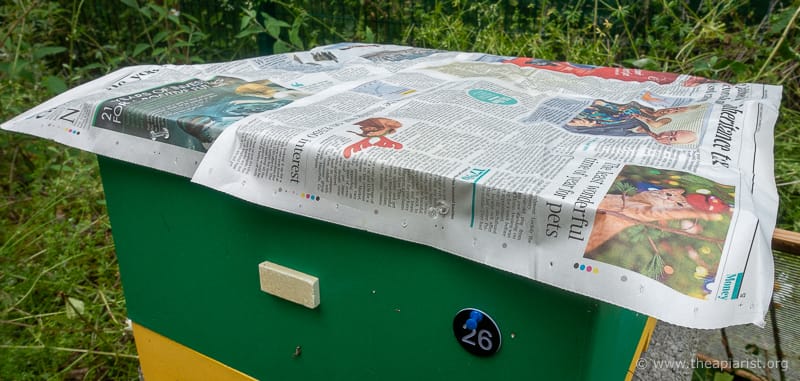
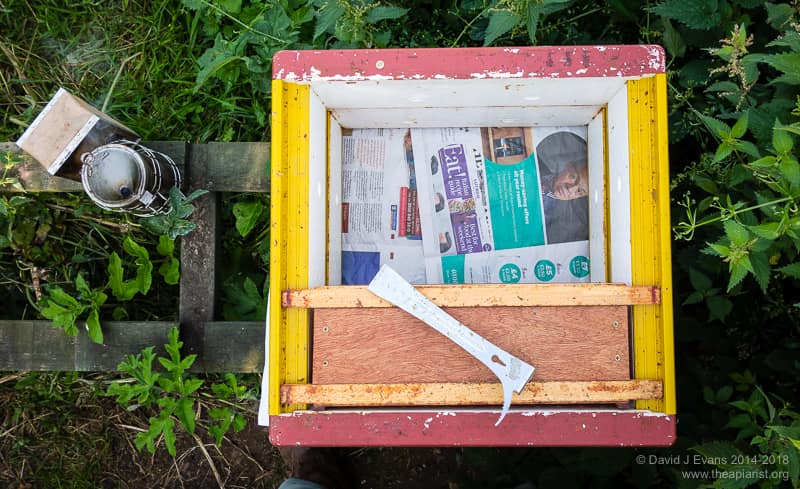

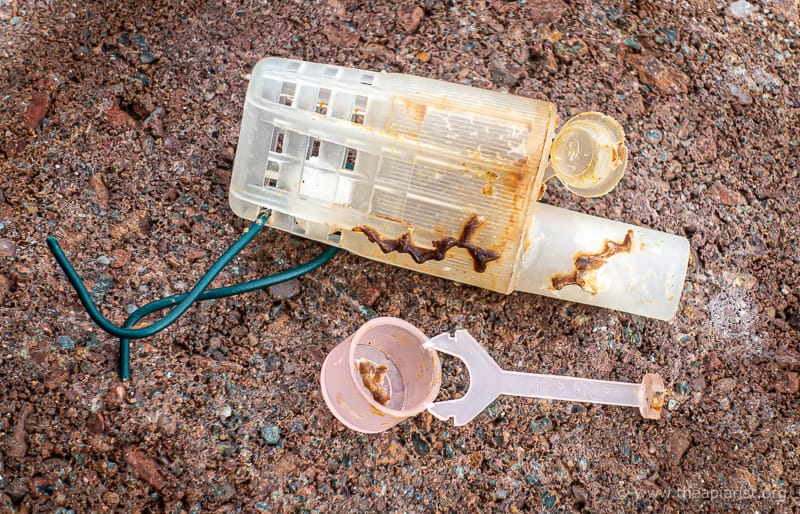

Join the discussion ...